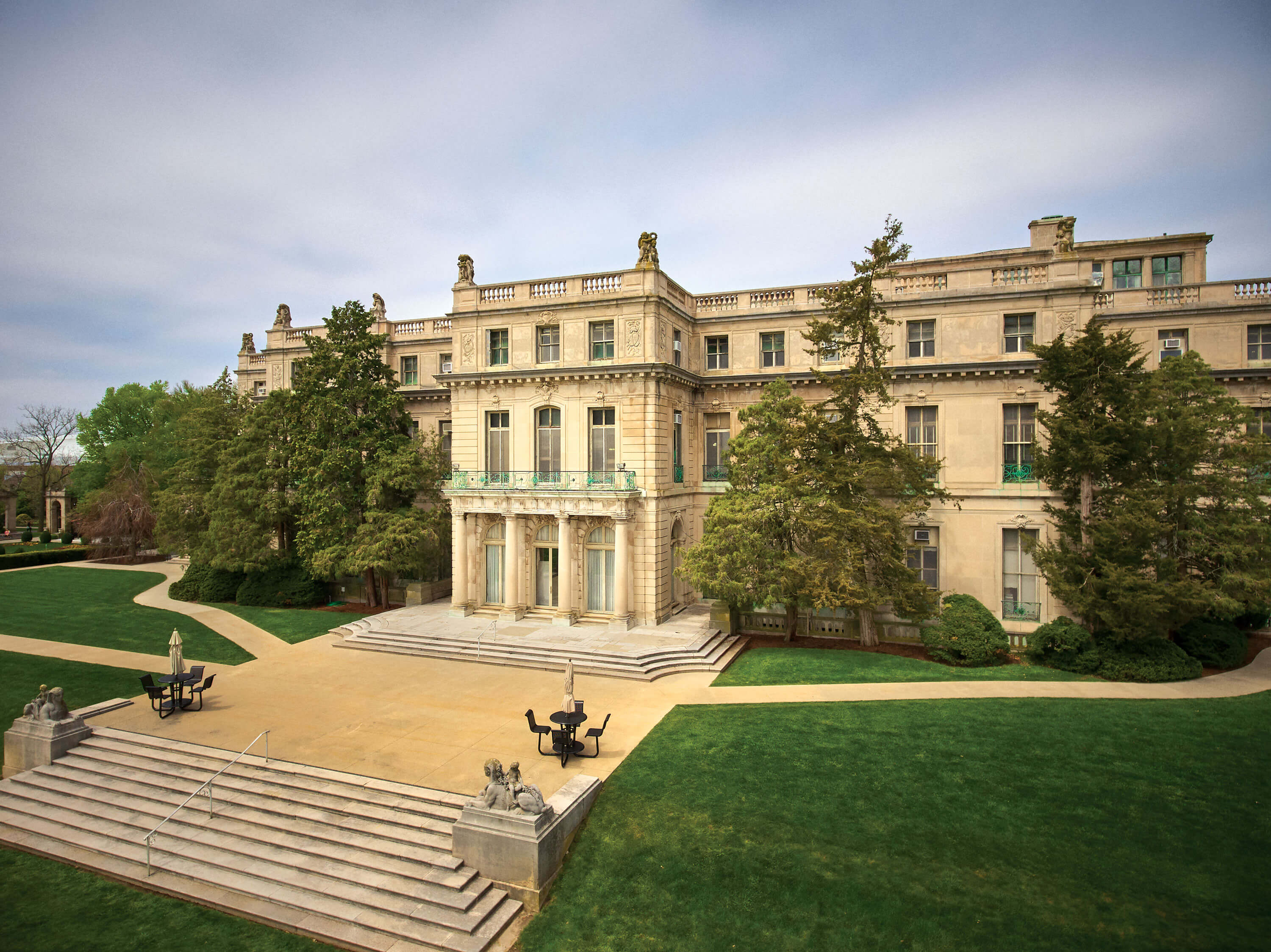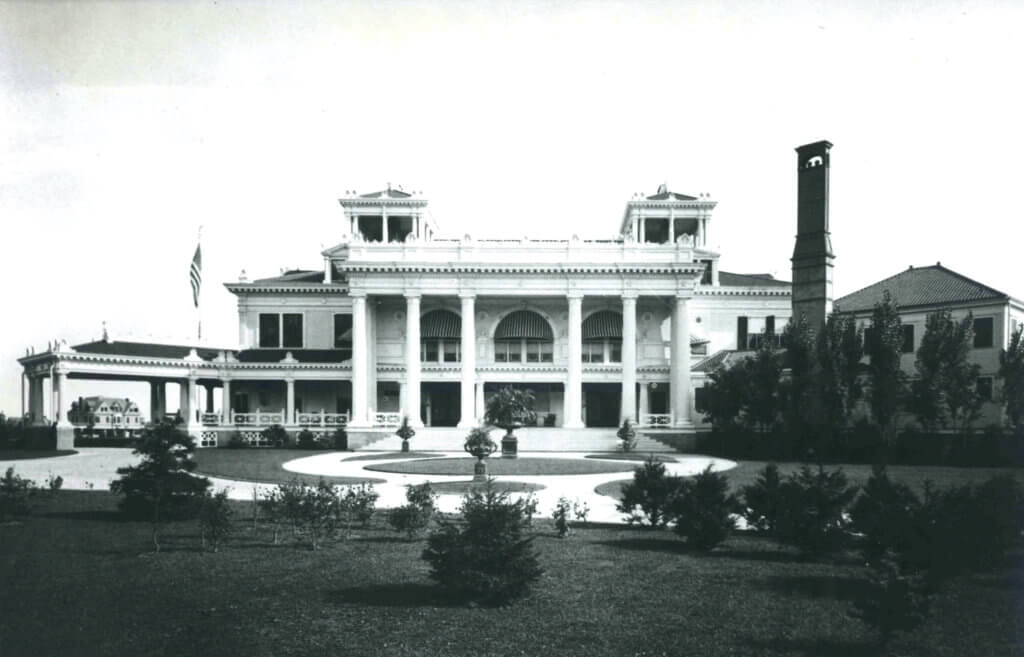
What’s In a Name?
The history behind the many monikers of Monmouth’s marquee building.
Long before Monmouth University was founded, the area upon which a portion of today’s campus stands was part of an estate called Shadow Lawn.
Named for the many trees that dotted the property, the estate was home to a wood-frame, colonial-style mansion that bore little resemblance to the building that would one day replace it and come to be associated with this University.
Built in 1903, the original Shadow Lawn mansion had 52 rooms and was referred to by one critic at the time as “all vocabulary and no rhetoric.” Nonetheless, it gained some notoriety in 1916 when its owner, Joseph B. Greenhut, head of the Siegel-Cooper Company, leased it to President Woodrow Wilson.
Wilson arrived at the original Shadow Lawn mansion on Sept. 1 and over the next several weeks ran his reelection campaign from the mansion’s steps. That “front porch campaign” earned the old building a nickname: the “Summer White House.” It also drew the ire of former President Theodore Roosevelt, who referenced the locale in a scathing speech he gave just days before the election.
“There should be shadows enough at Shadow Lawn,” Roosevelt said in condemning Wilson’s policy of nonintervention in Europe—despite direct attacks on U.S. citizens—as World War I unfolded. “The shadows of men, women, and children who have risen from the ooze of the ocean bottoms and from graves in foreign lands; the shadows of the helpless who Mr. Wilson did not dare protect.”
Wilson narrowly won reelection, though sources differ on when exactly he learned he had captured enough electoral votes to retain the presidency. One item not in dispute is that when Wilson left the old Shadow Lawn mansion on Nov. 9, 1916, he never again returned.
More than a decade later, in January 1927, the original Shadow Lawn mansion—which was then owned by Hubert T. Parson, president of F.W. Woolworth Company—burned to the ground.

Despite having just spent $1 million renovating the old mansion, the wealthy Parson decided to build a new, significantly larger structure on the original building’s footprint.
World-renowned architect Horace Trumbauer of Philadelphia was hired as the lead architect, while the interior design was led by Julian Abele, one of the first professionally trained African American architects in the country. Abele had already risen to prominence for his design work on various architectural projects, including the Philadelphia Museum of Art, Harvard University’s Widener Library, and Duke University’s west campus.
It took two years and $10.5 million to build the new Shadow Lawn mansion. When it was complete, it reached far beyond the glory of the former building, more than doubling the number of rooms. The new mansion included a bowling alley, an indoor swimming pool, and the stunning Great Hall, a three-story entrance hall highlighted by a grand staircase and a 100-foot- long Venetian stained glass skylight.
Parson suffered financial ruin during the Great Depression, and the mansion he had built eventually fell under municipal ownership in 1939.
In 1942, Highland Manor Junior College, a private girls’ school, acquired the Shadow Lawn mansion. It was during that school’s ownership of the property that the building’s name was changed to Woodrow Wilson Hall.
That name remained in use until 1955, when the University, which was then known as Monmouth Junior College, purchased the building and changed its name to the Great Hall. The building continued to be referred to as the Great Hall until 1966, when Monmouth College officials, in a nod to the history of the site (since Wilson had never physically been in the building that now stood there), rededicated the Great Hall as Woodrow Wilson Hall.
In the years since then,Wilson’s legacy has become complicated. Among his many accomplishments, he was awarded a Nobel Peace Prize for leading the establishment of the League of Nations. But it has been well documented by historians that Wilson was a racist who supported segregation and white supremacy. Therefore, as conversations of race exploded across the country earlier this year following the death of George Floyd, Monmouth’s Board of Trustees voted to remove Wilson’s name and rename the building the Great Hall at Shadow Lawn. In announcing its decision, the board noted the importance of taking into account the concerns of many Monmouth students, administrators, and faculty regarding Wilson’s racist legacy.
“Wilson was a controversial politician, who never actually set foot in the current building,” President Patrick F. Leahy and former Chair of the Board of Trustees Michael A. Plodwick ’82 said in a joint statement announcing the decision to the University community. “Removing his name, and incorporating these earlier names, connects the centerpiece of our campus more accurately to our historical roots and eliminates a symbolic barrier to the important work of creating a truly welcoming and inclusive space in the Great Hall.”
With the building’s name having been returned to its roots, efforts are underway to return the Great Hall itself to a central hub on campus. There are plans to build a coffeehouse on the first floor and to add furniture to create more common areas and study space for students. “We want more students, alumni, faculty, and staff to feel this building is a part of the central experience at Monmouth University,” Leahy said this fall.